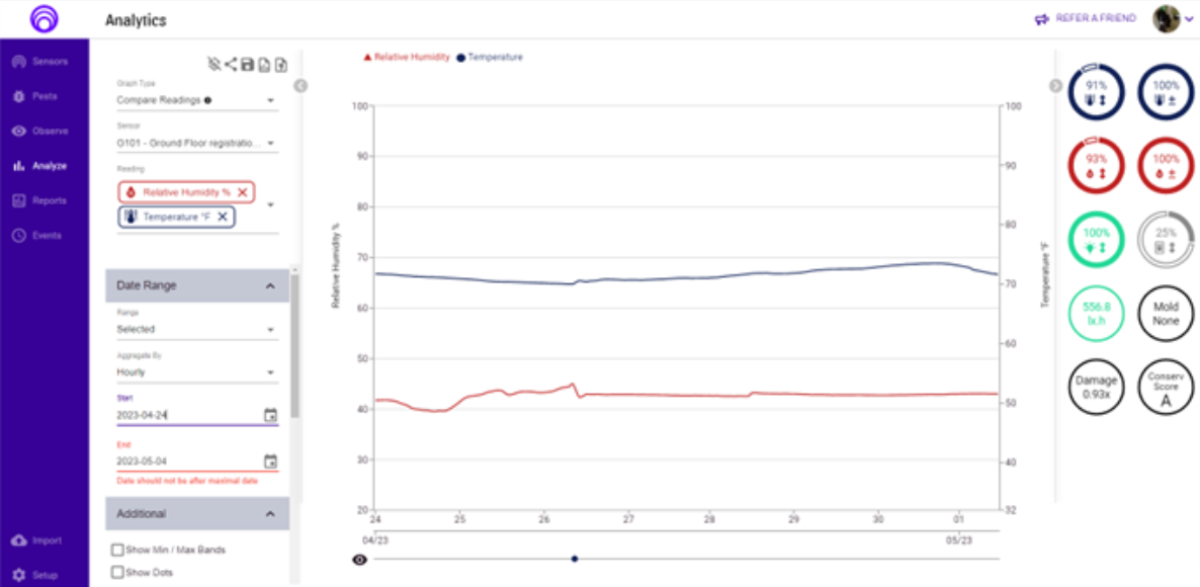Collections storage at McKissick Museum at the University of South Carolina is fraught with challenges because the building was not purpose built – a challenge that many museums deal with. Our issue is that the building was originally constructed as a library in 1940 with more than 10 separate areas for housing the stacks, which we now use for collection storage.
These spaces utilize varied heating and cooling systems that we monitored weekly. So, when we learned about Conserv environmental sensors and the ability to monitor spaces remotely, McKissick Museum was very excited to make the change to Conserv.
The McKissick Museum’s HVAC unit challenge
After switching 12 of the 15 collection and exhibition spaces in the museum to the Conserv system, we confirmed that McKissick’s 10-year-old HVAC units were unreliable when it comes to humidification and dehumidification of our spaces.
Additionally, several spaces are still using 40+ year-old fan coil units that are not up to maintaining the environmental standards of museums. Therefore, our best option for preventing risk to the collections was to ensure a sealed microenvironment inside our storage cases.
Enter the second stage of challenges… over 75 cases were purchased when McKissick Museum was founded in 1976 and the original foam gasketing had become brittle and friable. This friable gasketing not only wasn’t sealing the case door, but it also crumbled into the drawers onto objects when staff were accessing objects.
Finally, staff moved a Conserv sensor inside one of these storage cases, and found that humidity levels inside the case were the same as humidity levels outside the case, thus confirming the lack of a stable microclimate for the objects within.
Testing timelines and budgets for the project
This problem couldn’t be ignored any longer, and in the Spring of 2022, collections staff purchased enough closed-cell gasketing from Patterson Pope to replace the failed gaskets on 76 vintage storage cases.
Student staff tested the process of removing and installing the new material on 4 cases, and calculated the time needed to remove and replace the gasket at about an hour, with additional time needed to remove/replace all the objects from each case.
Because we had already purchased the gasketing and supplies for removing the old material, we were only lacking funds to support a student salary for the project. In November 2022, McKissick Museum applied for and was granted a Conserv Preventive Conservation Award to hire a USC student dedicated to completing this work within 3 months. While we initially planned to inventory each case as the objects were removed, this proved overly time consuming for this project timeline.
A protocol for storage case gasket replacement at McKissick Museum
In January 2023, a dedicated student worker, Natalie Truman, was hired onto the project. She is a sophomore at USC majoring in Physics and Astronomy with a strong background in natural history.
We created a checklist of materials she would need (Nilfisk vacuum, Goo Gone adhesive remover, alcohol, rags, scrapers, pencils, and new gasketing) along with a formal protocol for how to complete the project:
- Pull drawers from cabinets and move to tables.
- Label each drawer with a cabinet and drawer letter.
- Remove old gasketing from around the door opening and back wall of cabinet; scrape with plastic spatula.
- Use Goo Gone to remove remaining adhesive.
- Use alcohol to remove Goo Gone residue.
- Vacuum inside of case and surrounding floor area.
- Install new gasketing: ⅛” around door opening; ¼” on back wall as materials last.
- Vacuum again if necessary.
- Place all old gasketing and backing of new gaskets in trash and dispose of it every day. Used rags can be placed in a trash bag and delivered to the curatorial office for washing.
- Wipe sides of drawers to remove powdered gray paint.
- Return drawers to proper cabinets in proper order. Replace any missing drawer labels.

USC Sophomore Natalie Truman changes the gasketing in the McKissick Museum display cases.
One final test… staff once again moved a Conserv sensor inside a case and found that the humidity levels inside the case were lower than humidity levels outside the case.

Screenshot of Conserv Cloud showing the humidity inside the case was not affected by the heavy rainstorms outside the McKissick Museum between April 29th-30th, 2023. The red RH line remains flat after the 26th of April when the sensor was put in.
The sensor was moved on April 26th, 2023 and the red relative humidity (RH) line changes from fluctuating between 40% to 45% to a flat line around 43%. This may not seem critical for the 5-day period tested. However, this space is not controlled by a modern HVAC system and humidity regularly fluctuates following weather patterns. We experienced a heavy rainstorm between April 29th-30th, and the humidity inside the case never changed. Mission accomplished!
Stable, sustainable, and cost-efficient environmental microclimates for preservation
The goals of this project extended beyond simply updating old cabinets. With the new closed-cell gasket, we are now able to maintain a stable environmental microclimate within each case.

Goo Gone adhesive remover, 70% isopropyl alcohol, and new gasketing used to replace old gasketing in McKissick Museum cases.
The need for this buffering has become more critical now that we know the humidity in collection spaces is fluctuating beyond recommended set points. We are happy to report that the University has purchased 10 commercial grade dehumidification units, which helps battle the high humidity of summers in SC.
This improvement along with replacing failed gaskets in our collection cases is a simpler and less expensive option than replacing multiple HVAC units, ensuring an additional level of confidence that McKissick Museum’s collections are stored in as close to ideal conditions as are obtainable.
McKissick Museum is very grateful to Conserv for this award and for their staff’s continued guidance and advice in helping us achieve our environmental goals.
If you have any questions about environmental monitoring, integrated pest management, or just want to talk about preventative conservation, please reach out to us! Don’t forget to check out our blog or join our community of collections care professionals where you can discuss hot topics, connect with other conservators or even take a course to get familiar with the Conserv platform.



